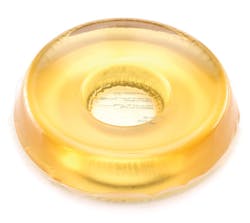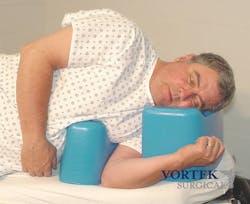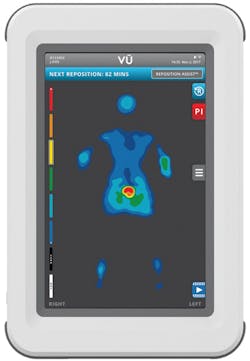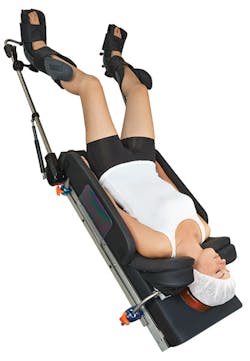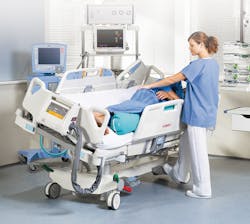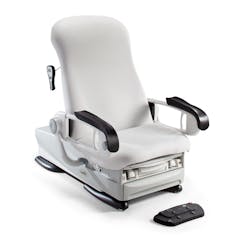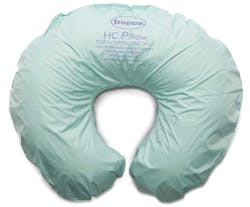Whether it’s during surgery or recovery, achieving the best outcomes requires consistent use of current guidelines and products that are proven to help clinicians keep their patients properly positioned and secure. Otherwise, hospital-acquired pressure ulcers/injuries (HAPU/I) and other complications can result, causing patients needless pain and suffering, additional costly treatment, and increased length of stay. Moreover, healthcare providers are left bearing the associated costs and other negative consequences resulting from events that could have been prevented.
A call to action
More than 2.5 million patients in U.S. acute-care facilities annually are estimated to suffer from pressure ulcers and injuries, and 60,000 die from their complications, according to The Joint Commission Center for Transforming Healthcare. That’s why the Center is currently collaborating with teams at The Johns Hopkins Hospital, Kaiser Permanente South Sacramento Hospital and Memorial Hermann Southeast Hospital to identify root causes of HAPU/I and the solutions for reducing such rates. The project is scheduled to end this summer followed by an analysis of outcomes that they hope can be replicated at other healthcare institutions.
Meanwhile, in October, 2018, British researchers at the University of Salford, in the first study of its kind, found that older populations with chronic, complex health conditions, such as asthma, dementia, arthritis, Parkinson’s and other ailments are more likely to remain in one position for longer periods of time compared to others. This can create or exacerbate existing problems with breathing, circulation, digestion and increase risk of death in some cases. The study looked at the effect positioning equipment used during sleep had on long-term care residents with a variety of chronic conditions between the ages of 51 and 89. The results were significant, with many subjects experiencing improved nutrition and fluid intake, positive weight gain, better sleep, decreased risk of choking and the reduction or elimination of prescribed medications.
Furthermore, researchers in Utah were able to use data and machine learning to help predict risk for pressure injuries in critical care patients. This study, published in the November 2018 issue of American Journal of Critical Care, entailed examining large amounts of clinical data in patient records and the relationships among available predictor variables, such as time required for surgery, body mass index, hemoglobin level, creatinine level and age. “Eventually, the model could help identify which patients are at the greatest risk for developing pressure injuries and who would benefit from interventions such as specialty beds or more frequent skin inspection,” the research stated. “The next step will be to validate and evaluate the model in a new sample of patients.”
As the above research demonstrates, greater weight is being placed on implementing a team-collaborative approach to identifying risk based on specific factors and applying evidence-based prevention strategies to reduce adverse events.
“A multi-step approach is being taken to address learning gaps in perioperative nursing procedures and for evaluating skin integrity based on risk factors such as BMI and length of surgery,” said Sally Fulmer, an Action Products Marketing Manager. “An emphasis is being placed on improving the quality of hand-off communication between OR staff and recovery units. Product guides are also being used to assist staff in choosing the appropriate products for the patient position.”
Gel works well
Pointing to the Association of Perioperative Registered Nurses (AORN) 2017 Guidelines for Patient Positioning, which states that a viscoelastic gel overlay surface is most effective for preventing pressure injury, Fulmer says Action Products’ Action OR Overlays made from Akton polymer are used in hospitals worldwide to successfully reduce incidence of pressure injuries.
“The Action OR Overlay is a versatile pad used for a wide range of procedures,” she said. “The small size is often used for rectoscopy support during proctology procedures; the medium size is ideal for open-heart cases and other procedures that mandate lengthy supine patient positions as well as pediatric procedures. The full-length pad is ideal for open-heart surgery and other thoracic and abdominal procedures and is a simple way to upgrade the performance of a foam table pad providing head to heel protection. The full range of Action Support Surfaces feature pressure management and infection control designs to protect patients from pressure injury.”
Anna Ginnity, Vice President, Sales and Marketing, Advance Medical Designs, also sells a gel-based positioner that healthcare providers are using to prevent pressure ulcers on some of the most vulnerable areas of a patient’s body: back of the head, tailbone, elbows and heels. She says they also help to increase surgical output. “By using patient positioners, hospitals can decrease the risk of infections in their patients which leads to being able to administer more surgeries and treat more cases throughout the year,” Ginnity asserted. “Advance Medical Designs’ SMARTGuard Gels are made with a gel polymer meaning they are non-porous. These patient positioners can be cleaned and disinfected before being reused on future cases. This reduces costs while also improving infection control efforts within the operating room.”
Using interface pressure mapping to test the effectiveness of the SMARTGuard Gels, Ginnity said the positioners were able to evenly distribute “pressure throughout the patient’s body to significantly lower the risk of developing a pressure related injury during surgery. The average pressure that was indicated on the GELDA3 was 26.12mmHg which is significantly less than if a patient was not positioned correctly with some sort of barrier between their head and the operating room table.”
GI solutions
Tom Szymczak, President, Vortek Surgical, provides GI endoscopy clinicians with positioning products designed to prevent a host of complications that can occur when GI patients aren’t supported properly. “For the patients undergoing a procedure, this can include airway compromise, risks for aspiration unless adequate attention is placed on elevation and head position, post procedural neck, back and shoulder pain and discomfort, corneal abrasions from friction that can occur from head movement or settling under conscious sedation, or potential fall injuries from inadvertent rolling or shifting during the procedure or recovery,” said Szymczak. “Patient positioning in GI endoscopy has historically been overlooked, with patient comfort often seeming an afterthought through the use of a bed pillow or triangular wedges that slide out of place as a patient moves or shifts.
“The risks are not just for the patients, as procedure staff can also be exposed to risks from repetitive motions or muscle strains from manually holding a patient in position or otherwise trying to compensate for inadequate position during a procedure,” he continued. “The most frequent challenges we see in GI endoscopy include trying to maintain patient stability in sidelying to prevent the all-too-common listing or posterior rolling that occurs with sedation, or straining to maintain adequate position and alignment of the head and neck for airway management and to promote scope advancement, which can be a significant challenge with a sedated patient.”
Szymczak says the U.S.-made, reusable EPS-30 positioners from Vortek Surgical provide comfort and safety to patients undergoing a variety of GI endoscopy procedures such as colonoscopy, EGD, ERCP, and others. “The EPS-30 positioners are specially designed to meet the positioning requirements for procedures performed in the standard left lateral, prone or supine position, and readily adapt to accommodate the position changes often required during these procedures,” he explained. “We have even had patients call inquiring about purchasing an EPS-30 positioner to sleep on at home, reporting it was the first time they could remember being able to lay on their side for that long without the shoulder pain that usually accompanied this position.”
Clear-cut and constant
Technological advances in positioning also deliver visual and/or audible alerts, based on precise monitoring data, to identify exactly when, where and why patients need to be moved or turned to avoid potential injury. “Even as healthcare providers follow international guidelines for turning and positioning patients, studies have shown that in most cases high pressures still exist under most patients,” said Kristen Thurman, PT, CWS, Vice President, Clinical Affairs, Wellsense. Conversely, Wellsense’s VŪ technology is constantly monitoring and identifying areas of high pressure beneath patients. When the clinician responds to an alert, the technology also evaluates the action taken and provides feedback on its effectiveness.
“Healthcare providers have found they are able to consistently perform interventions to further lower patients’ exposure to pressure and lower their incidence of pressure injuries, when they are given this tool,” Thurman added. “The VŪ is even able to guide healthcare providers through a successful reposition, both providing feedback that pressure was, in fact, moved from one body plane to another, and even more importantly, lowered over the entire body in contact with the support surface. To help increase nursing efficiency, VŪ automatically detects turns and enables healthcare providers to track existing PIs at the bedside ensuring patients are not positioned on those already damaged areas. Additionally, a patient engagement component helps educate patients to maintain positions of low pressure and comply with nursing staff.”
Stephen Dunn, Product Manager, Alimed, said advancements in procedural technology (e.g., robotic surgery) have shortened procedure and recovery times but they also demand extreme positioning which has its own set of problems.
“Frequently, Trendelenburg positioning is used during a robotic procedure and brings with it a different worry: gravity. A patient moving as little as an inch on the table during a procedure can complicate and lengthen the time they will be on the table,” said Dunn, adding that larger patients are an even greater challenge with cephalad (toward the head) shifting occurring more frequently in this population. “In order to combat this shifting some positioners have implemented a strap over the patient’s chest, taking table rail space and complicating access for the anesthesiologist,” Dunn continued. “AliMed’s SecureFit TPS was engineered to minimize patient slipping while maximizing pressure redistribution, by creating a natural cradle with the cure of the patient scapula. Patients’ arms are protected while still allowing open access [so] the IV lines are safe and kept out of the way. The AliMed’s SecureFit can be setup in less than one minute which he says has saved facilities 15 to 30 minutes from most DaVinci robotic procedures.
Better beds and chairs
Molly Dudek, LPTA, CEAS, Clinical Applications Specialist for LINET applauds today’s technology but stresses that the goal shouldn’t be to lessen patient contact. It should enhance it. “For LINET products, the advanced technology is to make human interaction more efficient and potentially improve the satisfaction of the caregivers and patients,” Dudek said. “LINET’s unique platform based lateral tilt technology aids in patient repositioning, caregiver safety and ergonomics.”
Dudek says LINET beds come with a variety of features to support the health and wellbeing of both patient and caregiver. To name just a few, LINET’s open architecture design accommodates various mattresses specific to different wound-care needs. The frame-based turn technology increases airflow while decreasing shear and friction. One-touch buttons and controls including, Mobi-Lift, makes it easier to stand, increasing earlier mobility and less risk of pressure injury.
“LINET’s wide range of bed frames and mattresses offer the ability to customize to the needs of specific populations without losing the benefits of the standard features that provide exceptional positioning options,” said Laura Enright RN, CCRN, Clinical Specialist for LINET. Enright also discussed the important connection between climate and moisture in the environment, the impact it can have on skin, and risk of pressure injury.
“Microclimate Management (MCM) as a feature has increased its popularity to maintain the best skin temperature and climate for pressure injury prevention,” she said. LINET’s microclimate management circulates air below the mattress cover which aids in pressure injury prevention by helping to control the heat and humidity of the patient’s skin.
Accurate blood pressure (BP) measurement may be an obvious and critical component of point-of-care diagnosis, care, and treatment, but the connection it has to patient positioning is often less clear. Midmark Corp.’s Marketing Manager Maria Moeller says BP measurement happens to be one of the most inconsistently performed tests and explains why proper positioning plays a crucial role in getting it right.
“Many healthcare providers are not aware of current standards for proper BP measurement. In fact, 9.8 percent of the population is affected by overestimation of high blood pressure errors,” Moeller said. “While a patient’s position during BP acquisition may seem insignificant, variations in positioning and technique can lead to fluctuations of 5 to15 mmHg in systolic BP. Reviews suggest that even a difference of 5 mmHg can affect close to 16 percent of patients, either inadvertently placing them on medication or missing a diagnosis of hypertension.”
Midmark’s unique 626 Barrier-Free Examination Chair provides a solution designed to help prevent those problems from happening. “Midmark designed the Barrier-Free chair to ensure clinical standards for blood pressure capture can be easily followed across the health system. The exam chair functions as a part of a fully integrated point of care ecosystem in the exam room,” Moeller said, adding that the chair can be lowered to the exact and correct height for measuring BP accurately. “This is accomplished through powered movement of the chair back section to ensure patient back support; patient support arm rails at heart height; and automated BP measurement through connection with a diagnostic device with data sent directly to the electronic medical records system to help reduce transcription errors. The exam chair helps to standardize proper patient positioning for more accurate BP measurement, based on guidelines from the American Heart Association and American Medical Association.”
Support for baby and mom
When new mothers have trouble breastfeeding their newborns sometimes it might be a matter of poor positioning, says Amanda Krusoe, Sales Development Manager, The Boppy Company. “Proper positioning from the start is critical to breastfeeding success. Regardless of the position that the mother chooses — a sitting position with the baby in her arms, a stretched out position with the mother and baby both on their sides, or the rugby or football position where the baby’s body is under the mother’s arm while she cradles the baby’s head — proper support is required to ensure good nipple attachment,” said Krusoe, noting research from La Leche League International.
The Boppy Healthcare Feeding Pillow is one solution that makes the process simple and successful. “This type of pillow is specifically designed to cradle the newborn into a position that is both beneficial to the child and ergonomically comfortable for the mother,” Krusoe asserted. “If we could achieve 90 percent compliance with the goals of the Healthy People objectives, including exclusive breastfeeding at 6 months, the U.S. could save as much as $13 billion per year in healthcare costs. Long-term breastfeeding success is best achieved with proper instruction, intervention and tools in the first critical days postpartum.”
In an online patient survey, 88.4 percent of moms felt they left the hospital successfully nursing after using the Boppy HC Pillow in the hospital versus hospital bed pillows where only 62.3 percent of moms felt they left the hospital successfully nursing.
“We’ve found that the Boppy HC Pillow is especially helpful in hospital beds. Optimal positioning makes breastfeeding more comfortable and sets the stage for continued success after discharge,” said Gina Minert, RNC, IBCLC Nurse Director, Presbyterian/St. Luke’s Medical Center, Denver, CO.
About the Author

Valerie J. Dimond
Managing Editor
Valerie J. Dimond was previously Managing Editor of Healthcare Purchasing News.


